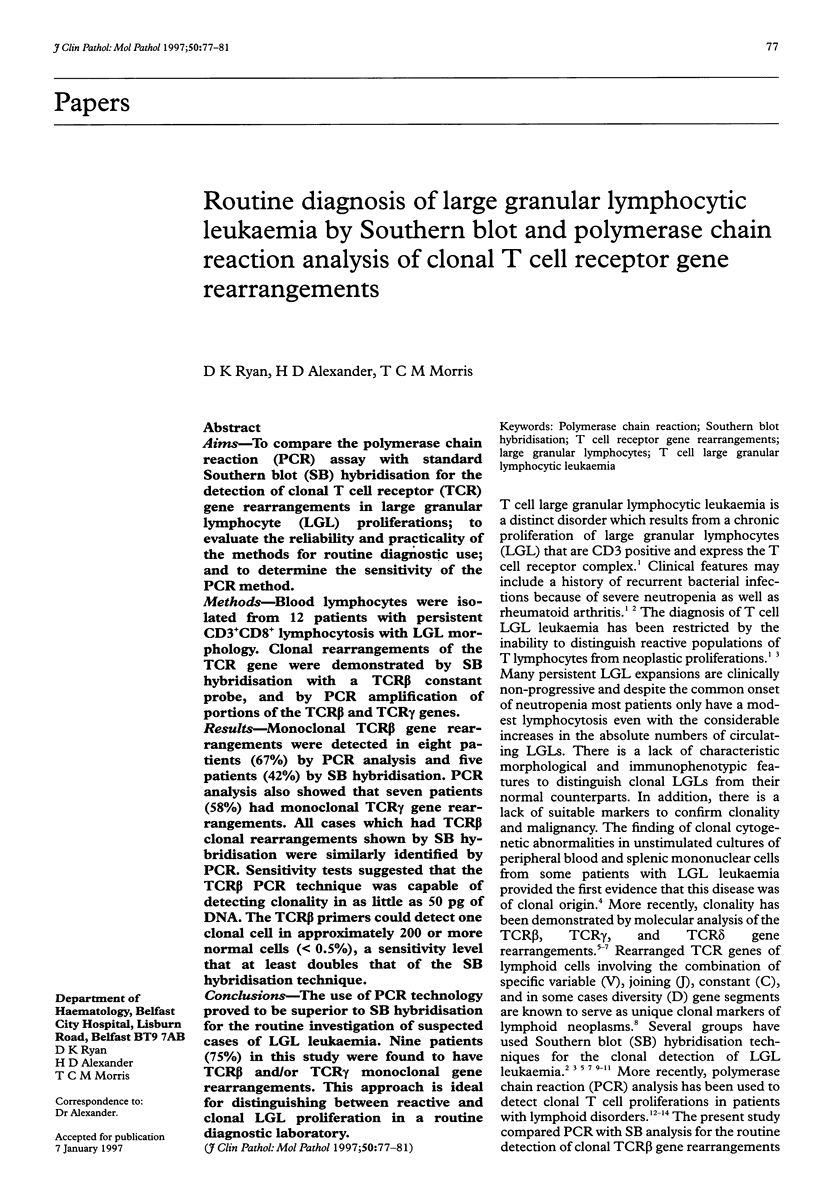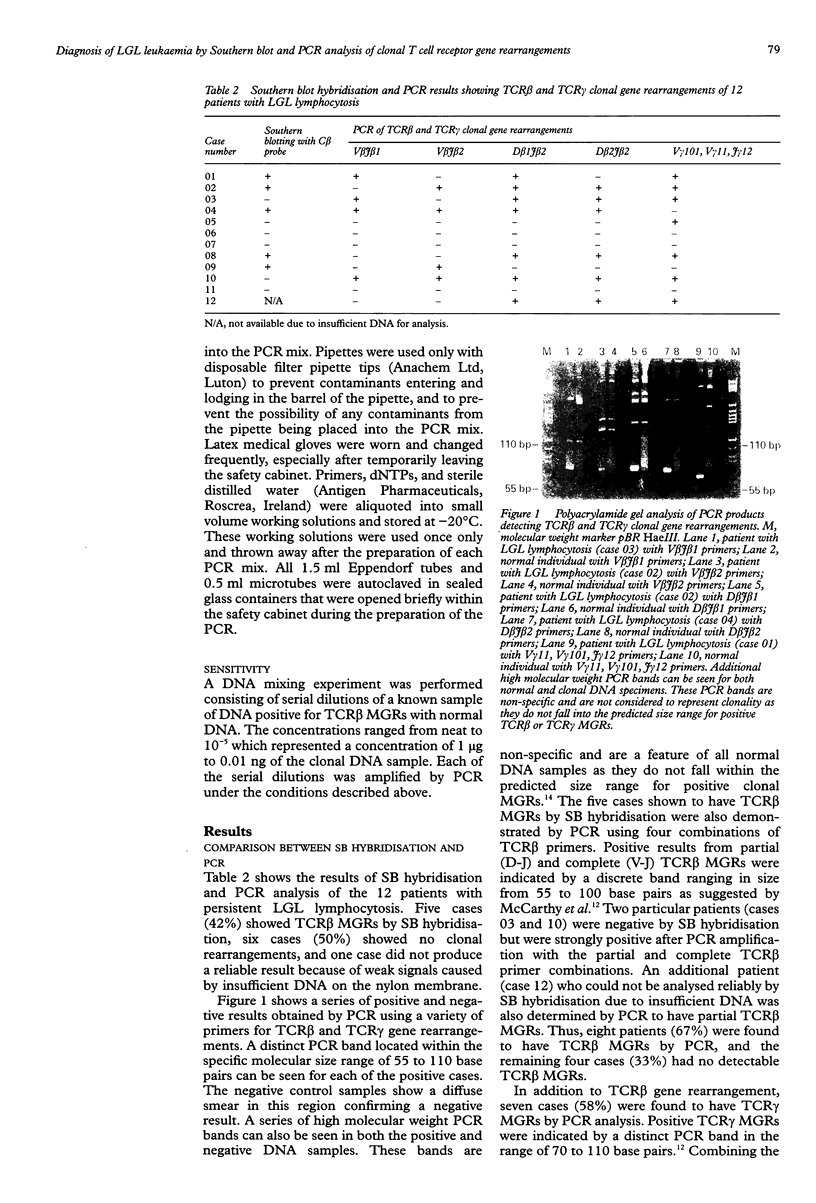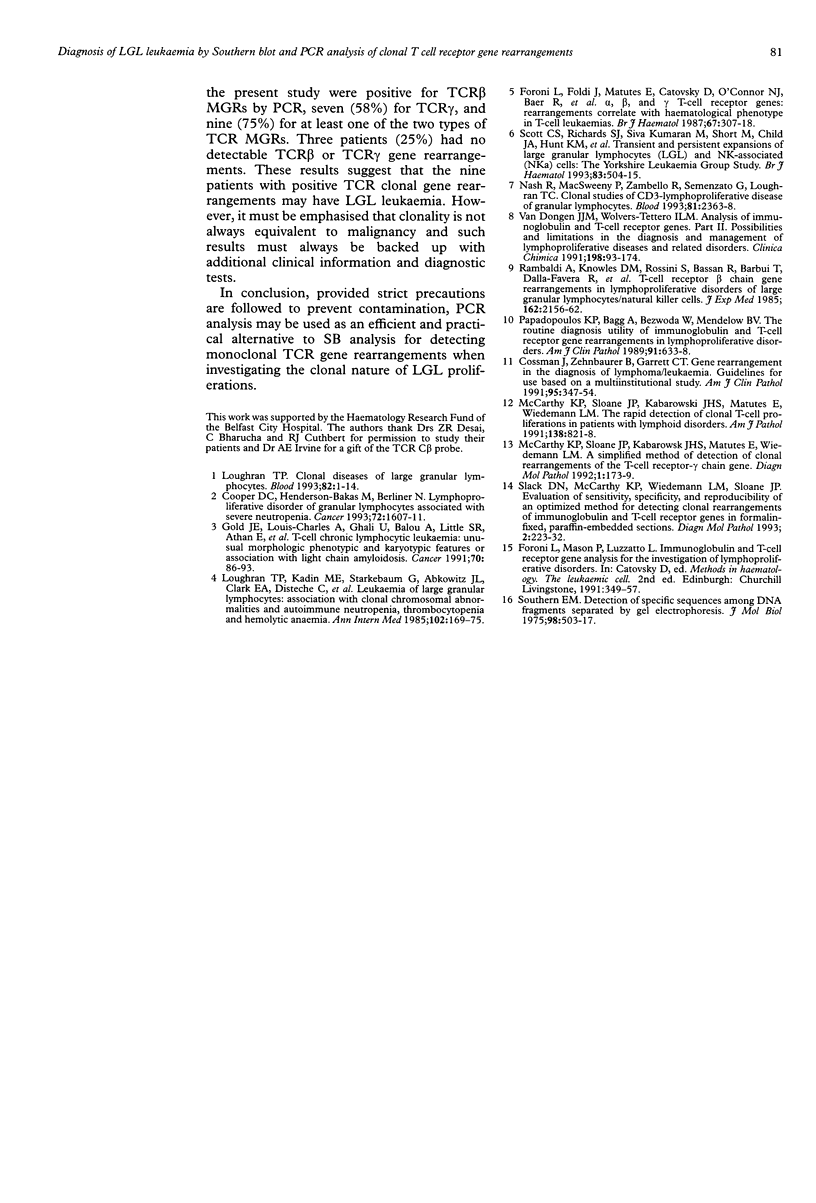Abstract
AIMS: To compare the polymerase chain reaction (PCR) assay with standard Southern blot (SB) hybridisation for the detection of clonal T cell receptor (TCR) gene rearrangements in large granular lymphocyte (LGL) proliferations; to evaluate the reliability and practicality of the methods for routine diagnostic use; and to determine the sensitivity of the PCR method. METHODS: Blood lymphocytes were isolated from 12 patients with persistent CD3+CD8+ lymphocytosis with LGL morphology. Clonal rearrangements of the TCR gene were demonstrated by SB hybridisation with a TCR beta constant probe, and by PCR amplification of portions of the TCR beta and TCR gamma genes. RESULTS: Monoclonal TCR beta gene rearrangements were detected in eight patients (67%) by PCR analysis and five patients (42%) by SB hybridisation. PCR analysis also showed that seven patients (58%) had monoclonal TCR gamma gene rearrangements. All cases which had TCR beta clonal rearrangements shown by SB hybridisation were similarly identified by PCR. Sensitivity tests suggested that the TCR beta PCR technique was capable of detecting clonality in as little as 50 pg of DNA. The TCR beta primers could detect one clonal cell in approximately 200 or more normal cells (< 0.5%), a sensitivity level that at least doubles that of the SB hybridisation technique. CONCLUSIONS: The use of PCR technology proved to be superior to SB hybridisation for the routine investigation of suspected cases of LGL leukaemia. Nine patients (75%) in this study were found to have TCR beta and/or TCR gamma monoclonal gene rearrangements. This approach is ideal for distinguishing between reactive and clonal LGL proliferation in a routine diagnostic laboratory.
Full text
PDF




Images in this article
Selected References
These references are in PubMed. This may not be the complete list of references from this article.
- Cooper D. L., Henderson-Bakas M., Berliner N. Lymphoproliferative disorder of granular lymphocytes associated with severe neutropenia. Response to granulocyte colony-stimulating factor. Cancer. 1993 Sep 1;72(5):1607–1611. doi: 10.1002/1097-0142(19930901)72:5<1607::aid-cncr2820720519>3.0.co;2-n. [DOI] [PubMed] [Google Scholar]
- Cossman J., Zehnbauer B., Garrett C. T., Smith L. J., Williams M., Jaffe E. S., Hanson L. O., Love J. Gene rearrangements in the diagnosis of lymphoma/leukemia. Guidelines for use based on a multiinstitutional study. Am J Clin Pathol. 1991 Mar;95(3):347–354. doi: 10.1093/ajcp/95.3.347. [DOI] [PubMed] [Google Scholar]
- Foroni L., Foldi J., Matutes E., Catovsky D., O'Connor N. J., Baer R., Forster A., Rabbitts T. H., Luzzatto L. Alpha, beta and gamma T-cell receptor genes: rearrangements correlate with haematological phenotype in T cell leukaemias. Br J Haematol. 1987 Nov;67(3):307–318. doi: 10.1111/j.1365-2141.1987.tb02352.x. [DOI] [PubMed] [Google Scholar]
- Gold J. E., Louis-Charles A., Ghali V., Babu A., Little J. R., Athan E., Knowles D. M., Zalusky R. T-cell chronic lymphocytic leukemia. Unusual morphologic, phenotypic, and karyotypic features in association with light chain amyloidosis. Cancer. 1992 Jul 1;70(1):86–93. doi: 10.1002/1097-0142(19920701)70:1<86::aid-cncr2820700114>3.0.co;2-b. [DOI] [PubMed] [Google Scholar]
- Loughran T. P., Jr Clonal diseases of large granular lymphocytes. Blood. 1993 Jul 1;82(1):1–14. [PubMed] [Google Scholar]
- Loughran T. P., Jr, Kadin M. E., Starkebaum G., Abkowitz J. L., Clark E. A., Disteche C., Lum L. G., Slichter S. J. Leukemia of large granular lymphocytes: association with clonal chromosomal abnormalities and autoimmune neutropenia, thrombocytopenia, and hemolytic anemia. Ann Intern Med. 1985 Feb;102(2):169–175. doi: 10.7326/0003-4819-102-2-169. [DOI] [PubMed] [Google Scholar]
- McCarthy K. P., Sloane J. P., Kabarowski J. H., Matutes E., Wiedemann L. M. A simplified method of detection of clonal rearrangements of the T-cell receptor-gamma chain gene. Diagn Mol Pathol. 1992 Sep;1(3):173–179. [PubMed] [Google Scholar]
- McCarthy K. P., Sloane J. P., Kabarowski J. H., Matutes E., Wiedemann L. M. The rapid detection of clonal T-cell proliferations in patients with lymphoid disorders. Am J Pathol. 1991 Apr;138(4):821–828. [PMC free article] [PubMed] [Google Scholar]
- Nash R., McSweeney P., Zambello R., Semenzato G., Loughran T. P., Jr Clonal studies of CD3- lymphoproliferative disease of granular lymphocytes. Blood. 1993 May 1;81(9):2363–2368. [PubMed] [Google Scholar]
- Papadopoulos K. P., Bagg A., Bezwoda W. R., Mendelow B. V. The routine diagnostic utility of immunoglobulin and T-cell receptor gene rearrangements in lymphoproliferative disorders. Am J Clin Pathol. 1989 Jun;91(6):633–638. doi: 10.1093/ajcp/91.6.633. [DOI] [PubMed] [Google Scholar]
- Rambaldi A., Pelicci P. G., Allavena P., Knowles D. M., 2nd, Rossini S., Bassan R., Barbui T., Dalla-Favera R., Mantovani A. T cell receptor beta chain gene rearrangements in lymphoproliferative disorders of large granular lymphocytes/natural killer cells. J Exp Med. 1985 Dec 1;162(6):2156–2162. doi: 10.1084/jem.162.6.2156. [DOI] [PMC free article] [PubMed] [Google Scholar]
- Slack D. N., McCarthy K. P., Wiedemann L. M., Sloane J. P. Evaluation of sensitivity, specificity, and reproducibility of an optimized method for detecting clonal rearrangements of immunoglobulin and T-cell receptor genes in formalin-fixed, paraffin-embedded sections. Diagn Mol Pathol. 1993 Dec;2(4):223–232. [PubMed] [Google Scholar]
- Southern E. M. Detection of specific sequences among DNA fragments separated by gel electrophoresis. J Mol Biol. 1975 Nov 5;98(3):503–517. doi: 10.1016/s0022-2836(75)80083-0. [DOI] [PubMed] [Google Scholar]
- van Dongen J. J., Wolvers-Tettero I. L. Analysis of immunoglobulin and T cell receptor genes. Part II: Possibilities and limitations in the diagnosis and management of lymphoproliferative diseases and related disorders. Clin Chim Acta. 1991 Apr;198(1-2):93–174. doi: 10.1016/0009-8981(91)90247-a. [DOI] [PubMed] [Google Scholar]



